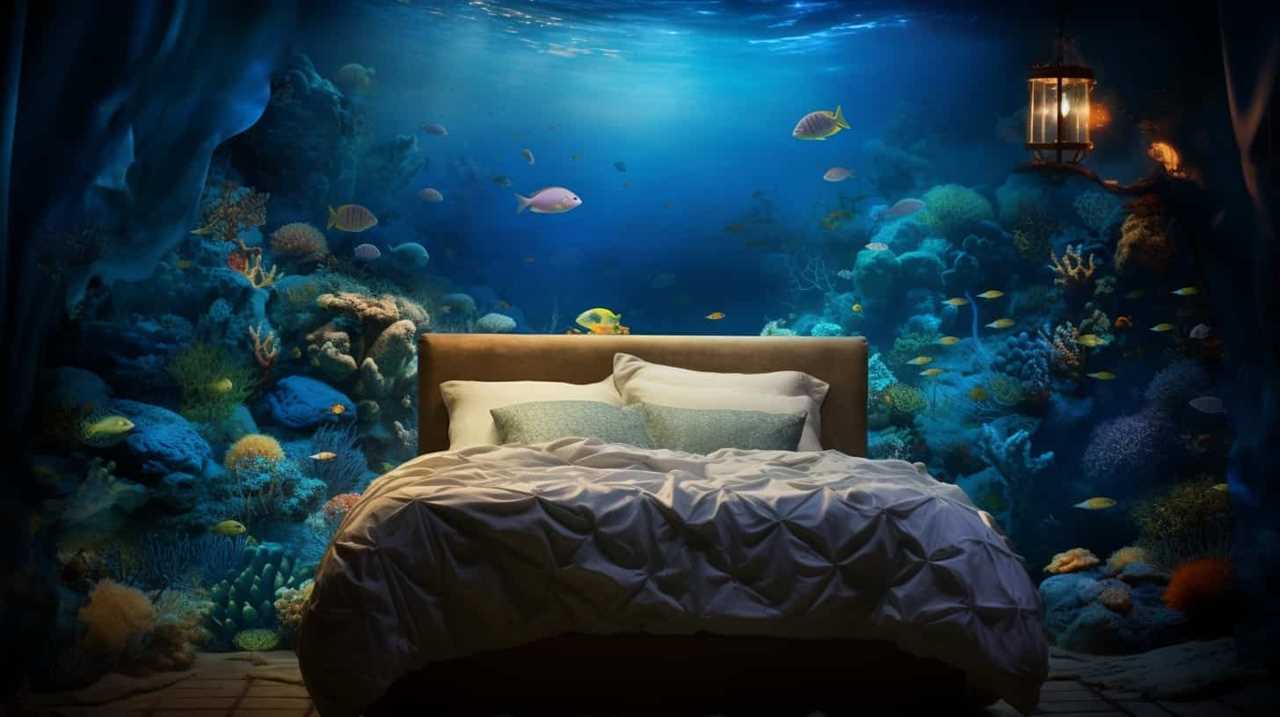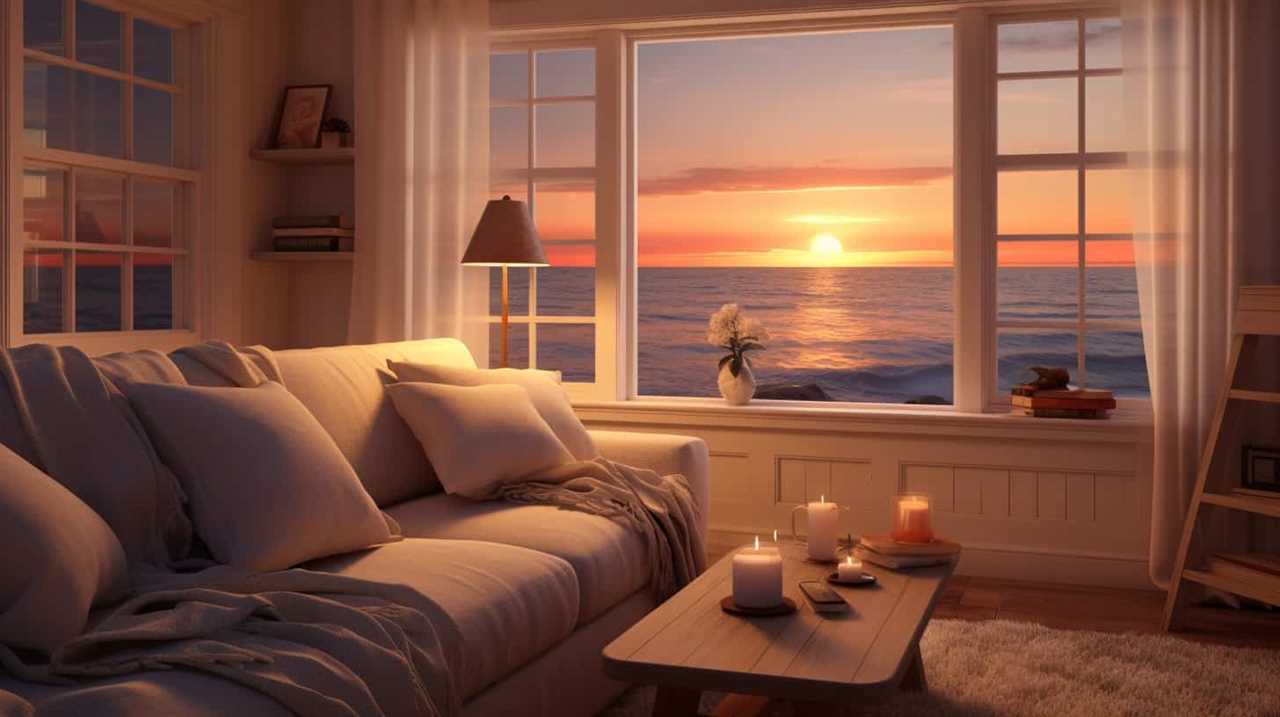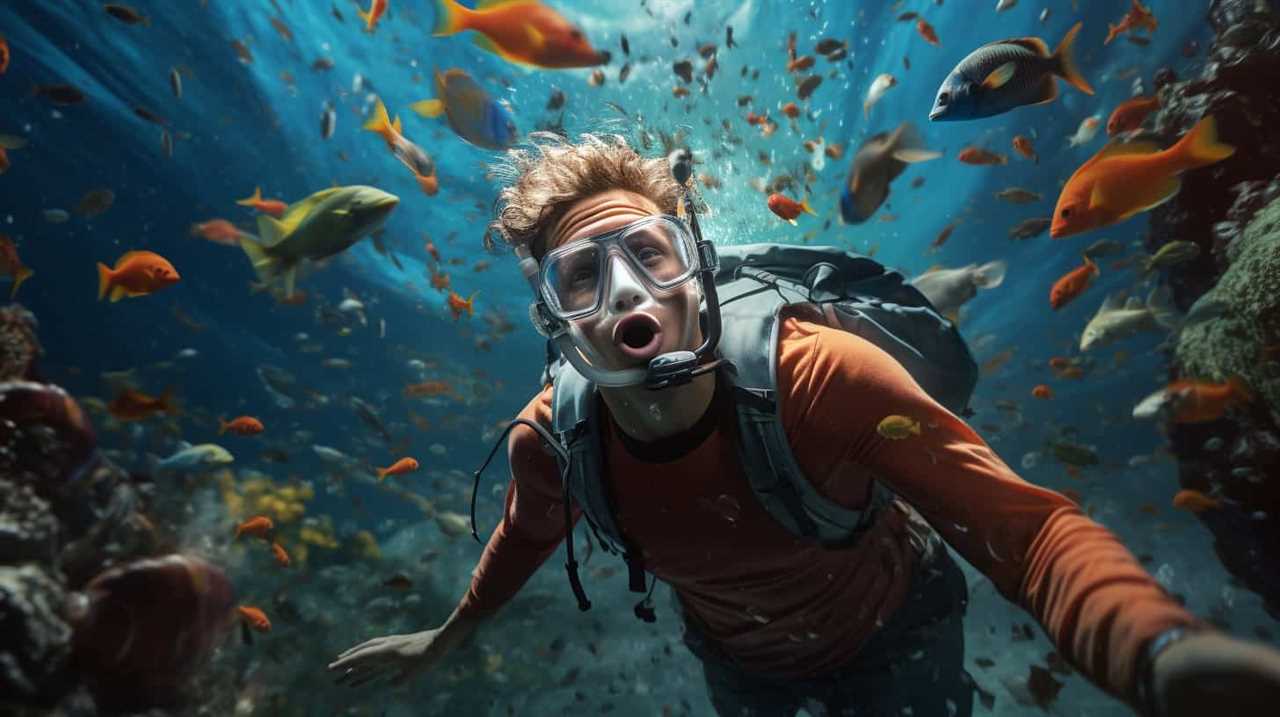Imagine yourself diving to the depths of the ocean, surrounded by the mesmerizing sound of the reverberating waves.
In this article, we’re going to show you how to harness the power of these captivating sounds to create truly cinematic compositions.
We’ll explore the benefits of incorporating ocean sounds, share techniques for recording them, and dive into creative ways to use them in film scores.
Get ready to embark on a journey of innovation as we unlock the secrets of blending sea echoes with music.

Key Takeaways
- Incorporating ocean sounds in film scores adds a unique and immersive element, evoking powerful emotions and symbolizing the vastness of the unknown and the ebb and flow of emotions.
- Techniques such as hydrophones, stereo recording, and binaural recording can be used to capture the spatial aspects and create dynamic and immersive ocean sound compositions.
- Specialized software, high-quality sound libraries, and online resources are valuable tools for adding realistic ocean sounds to compositions, bringing coastal wildlife to life and creating captivating underwater ambiance.
- Achieving a harmonious blend of ocean sounds and music involves carefully balancing the volume and intensity, using ocean sounds to complement and enhance the emotional impact of the music, experimenting with layering and blending, and paying attention to the timing and rhythm to create a cohesive sonic experience.
Benefits of Incorporating Ocean Sounds
Incorporating ocean sounds into our cinematic compositions offers us a multitude of benefits.
The psychological effects of ocean sounds in cinematic compositions are undeniable. The gentle ebb and flow of the waves can evoke a sense of calm and tranquility, transporting the audience to a serene and peaceful state of mind. The soothing sounds of the ocean can also have a therapeutic effect, reducing stress and anxiety.
Additionally, ocean sounds play a crucial role in setting the mood and atmosphere of a film scene. The crashing waves can intensify the tension in an action-packed sequence, while the soft lapping of the water can create a dreamy and romantic ambiance. By incorporating ocean sounds, we can immerse our audience in a world of emotions and sensations.
Now, let’s delve into the techniques for recording these enchanting sounds.

Techniques for Recording Ocean Sounds
To capture the mesmerizing soundscapes of the ocean, we employ various techniques for recording ocean sounds. Underwater acoustics play a crucial role in capturing the intricate melodies of the deep sea. We use hydrophones, specialized microphones designed to capture sounds underwater, to delve into the hidden world beneath the waves. These hydrophones pick up the subtle nuances of marine life, capturing the symphony of clicks, pops, and songs that fill the ocean. To further enhance our recordings, we utilize advanced recording equipment that allows us to capture the full dynamic range of the ocean sounds. By utilizing innovative techniques and technologies, we are able to create immersive compositions that transport listeners to the depths of the ocean, awakening their senses to the wonders that lie beneath.
| Technique | Description | Emotion |
|---|---|---|
| Hydrophones | Sensitive underwater microphones | Capturing the mysteries of the deep |
| Advanced Recording Equipment | High-quality gear for dynamic recordings | Evoking the power and grandeur of the ocean |
| Stereo Techniques | Capturing the spatial aspects of ocean sounds | Creating an immersive experience |
| Binaural Recording | Recreating the 3D sound of being underwater | Transporting listeners to the depths |
Creative Ways to Use Ocean Sounds in Film Scores
We love using ocean sounds in film scores to add a unique and immersive element to our compositions. Ocean sounds have a deep symbolism in film scores, representing the vastness of the unknown, the ebb and flow of emotions, and the constant movement of life. They can evoke a sense of tranquility, mystery, or even danger, depending on how they’re used.
One iconic movie scene that comes to mind is from the film ‘Jaws’, where the ominous sound of the ocean’s waves is used to build tension and foreshadow the arrival of the shark. Another example is the opening scene of ‘Titanic’, where the gentle sound of waves and seagulls sets a romantic and nostalgic tone.
Incorporating ocean sounds into film scores allows us to transport the audience to different worlds and evoke powerful emotions. Now, let’s explore some tools and resources for adding ocean sounds to our compositions.

Tools and Resources for Adding Ocean Sounds to Compositions
Using specialized software and high-quality sound libraries, we can easily enhance our film compositions with realistic ocean sounds. These tools allow us to create a captivating underwater ambience and bring coastal wildlife to life in our compositions. By incorporating the soothing sounds of waves crashing, the gentle whispers of the ocean breeze, and the calls of seagulls, we can transport our audience to the shores of a tranquil beach or immerse them in the depths of the ocean. In addition to these software and sound libraries, there are also online resources available that provide a wide range of ocean sounds and recordings. These resources enable us to find the perfect soundscape for our compositions, allowing us to create truly innovative and captivating cinematic experiences.
| Tool/Resource | Description | Benefits |
|---|---|---|
| Specialized software | Software designed specifically for adding ocean sounds to compositions | Provides advanced editing capabilities and realistic sound effects |
| High-quality sound libraries | Collections of professionally recorded ocean sounds | Offers a wide range of high-fidelity options |
| Online resources | Websites and platforms that offer ocean sound recordings | Provides a variety of options and easy accessibility |
With these tools and resources, we can elevate our film compositions to new heights, capturing the essence of the ocean and creating immersive and innovative cinematic experiences for our audience.
Tips for Achieving a Harmonious Blend of Ocean Sounds and Music
Achieving a harmonious blend of ocean sounds and music requires careful balance and precise timing. Sound design is of utmost importance in cinematic compositions as it sets the mood and enhances the emotional impact of the visuals. When it comes to incorporating ocean sounds into film scoring, there are a few tips that can help create a truly immersive experience for the audience:
-
Layering: Blend the ocean sounds seamlessly with the music, creating a rich and textured sonic landscape.

-
Emotional cues: Use the ebb and flow of the ocean sounds to mirror the emotional arc of the scene, evoking feelings of tranquility, suspense, or drama.
-
Dynamic range: Vary the volume and intensity of the ocean sounds to match the on-screen action, heightening the audience’s emotional engagement.
-
Timing: Pay attention to the timing of the ocean sounds and music, synchronizing them to create impactful moments and enhance the storytelling.
Frequently Asked Questions
What Are Some Popular Film Scores That Have Incorporated Ocean Sounds?
Popular film scores that have incorporated ocean sounds include "Titanic" and "The Beach." We can harness the power of ocean sounds in music composition by blending them with dynamic melodies and atmospheric textures, creating innovative and emotionally captivating cinematic compositions.

Are There Any Copyright Restrictions When Using Ocean Sounds in Compositions?
Copyright restrictions and legal implications should be considered when using ocean sounds in compositions. It is important to be innovative and push boundaries, but also respect the rights of others.
Can Ocean Sounds Be Manipulated or Edited to Create Unique Effects?
Yes, ocean sounds can be manipulated and edited to create unique effects. By altering the pitch, speed, and intensity of wave sounds, we can create an immersive underwater ambiance that adds depth and emotion to cinematic compositions.
Are There Any Specific Genres of Film That Benefit Most From Incorporating Ocean Sounds?
Different genres of film benefit uniquely from incorporating ocean sounds. By exploring the emotional impact of these sounds, we can create atmospheric and dynamic compositions that push the boundaries of traditional film scores.
How Can I Create a Realistic and Immersive Ocean Sound Experience for the Audience?
To create a realistic and immersive ocean sound experience, we focus on capturing the essence of the ocean through sound design. By creating dynamic soundscapes, we transport the audience to the depths of the sea, evoking emotions and pushing the boundaries of innovation.

Conclusion
As we immerse ourselves in the ethereal world of cinema, we discover the profound beauty of harnessing sea echoes in our compositions.
From the gentle lull of waves to the thunderous crash of the shore, the ocean offers a symphony of emotions that can elevate our film scores to new heights.
By diligently recording these captivating sounds and skillfully blending them with our music, we create a harmonious blend that transports audiences to a realm of pure atmospheric magic.
Let the sea be our muse, and let our compositions be a testament to its majestic power.











